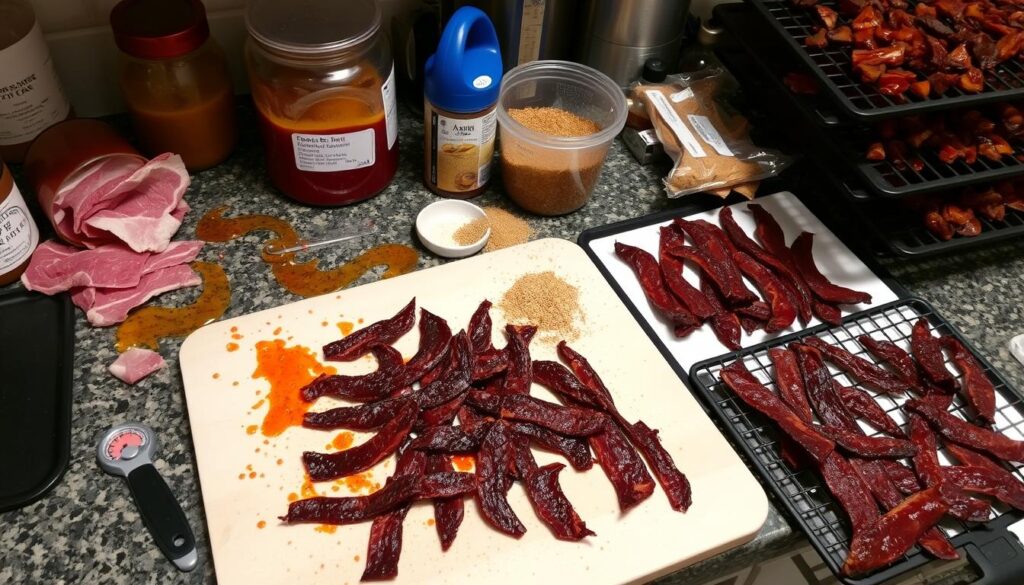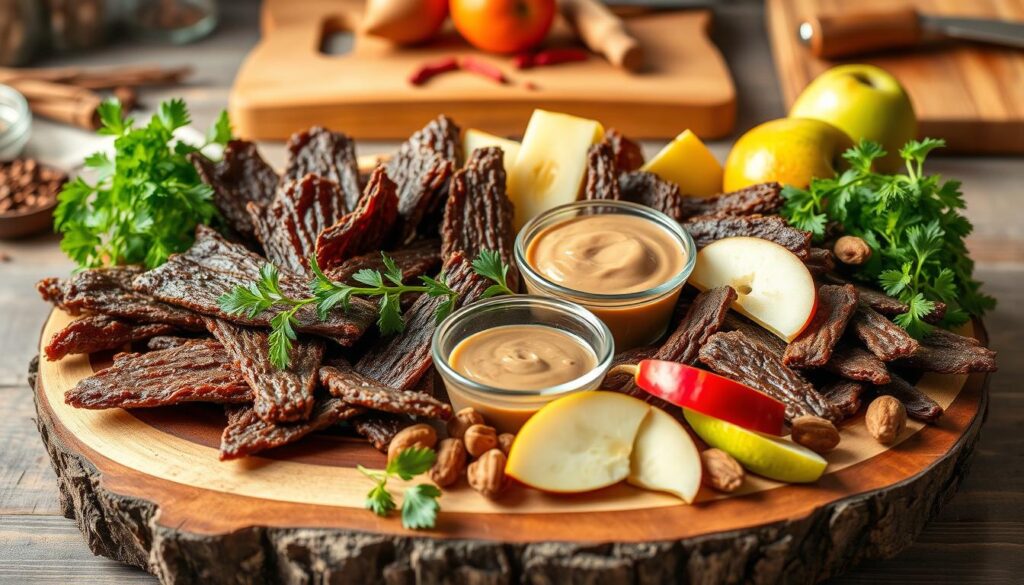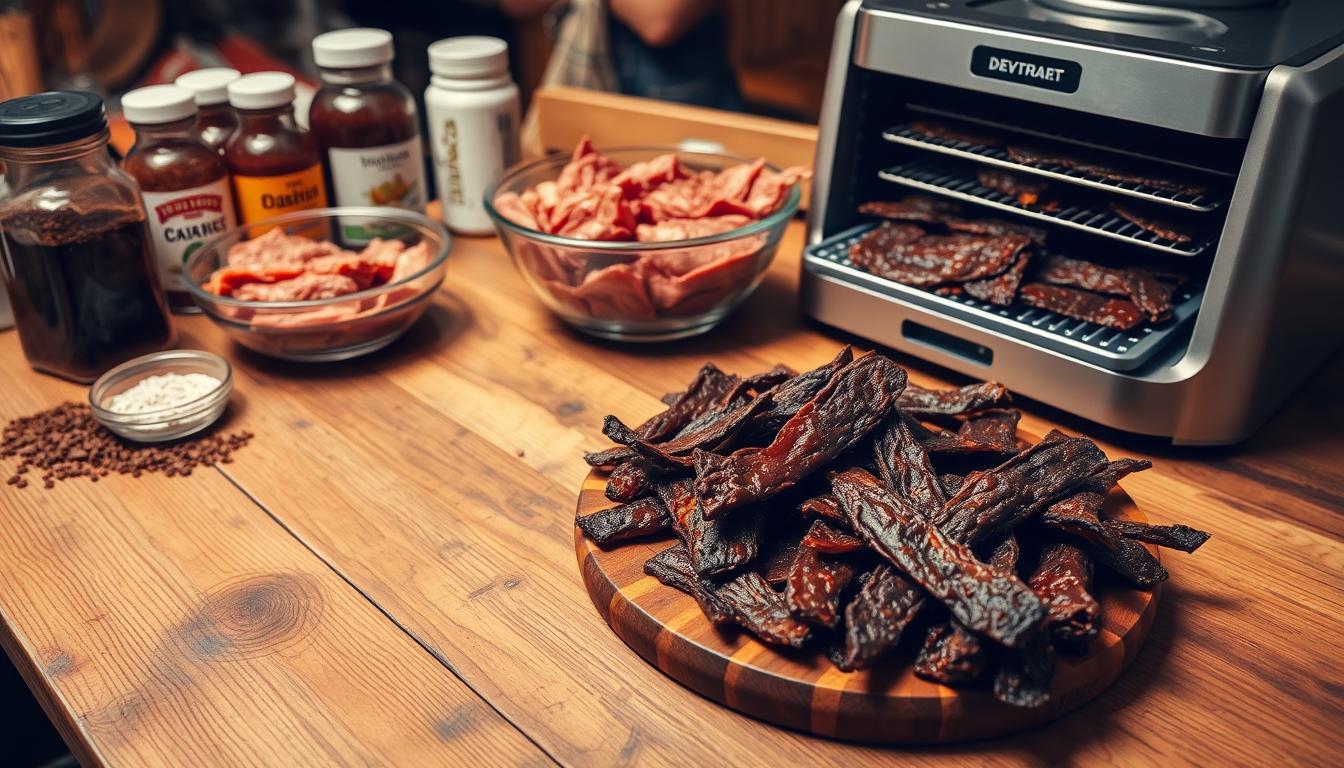Imagine being on a long hike, feeling hungry and hot. You grab a piece of homemade beef jerky from your bag. Made using your favorite beef jerky recipe, it’s a snack that makes your journey better. It shows off your cooking skills and love for adventure.
Making the perfect beef jerky is more than just a snack. It’s about creating a special moment. Store-bought jerky can cost over $20 a pound. But our recipe lets you save money and enjoy a better taste than store brands.
Homemade beef jerky is perfect for many situations. It’s ideal for road trips, camping, or whenever you need a quick protein boost. The best part is that you control every ingredient, ensuring the quality and taste you desire.
Table of Contents
Understanding the Basics of Beef Jerky
Beef jerky is more than a snack; it’s a tradition in food preservation. To make the best beef jerky, start by learning about its basics and history.
What is Beef Jerky?
A beef jerky recipe turns lean meat into a snack full of protein. It’s made by drying and seasoning the meat. This process removes moisture, making the snack flavorful and lasting for weeks.
- Made from thin slices of lean beef
- Typically seasoned with various spices
- Dried to remove moisture and concentrate flavors
History of Jerky
The history of jerky goes back to ancient times. Indigenous peoples and early travelers used it as a way to preserve meat. This was before refrigeration existed.
“Jerky was a survival food that allowed people to preserve meat for long journeys and harsh winters.” – Food Preservation Experts
Nutritional Benefits
Creating your best beef jerky recipe is not just about taste. It’s also about making a nutritious snack. Beef jerky is high in protein and low in carbs.
| Nutrient | Amount per 1 oz Serving |
|---|---|
| Protein | 9-10 grams |
| Calories | 80-90 |
| Fat | 1-3 grams |
By making your own beef jerky, you can choose healthier ingredients. Pick lean cuts and control your seasonings for a better snack than store-bought options.
Choosing the Right Cut of Meat
Starting a great beef jerky recipe means picking the right meat. The cut you choose can turn a simple snack into a tasty, protein-rich treat.
Best Cuts for Jerky Production
Learning about meat cuts is key when making beef jerky. The best cuts are:
- Eye of Round: Most tender and cost-effective cut
- Top Round: Preferred by commercial jerky producers
- Bottom Round: Offers excellent interior marbling
- Sirloin Tip: Extremely tender with minimal fat
Grass-Fed vs. Grain-Fed Considerations
Knowing where your meat comes from can improve your jerky. Grass-fed beef offers:
- Leaner meat profile
- More complex flavor
- Higher nutritional value
“The quality of your meat determines the quality of your jerky” – Jerky Artisan Wisdom
Precision Slicing Techniques
Slicing is crucial for your jerky. Here are some tips:
- Partially freeze meat for easier cutting
- Aim for uniform 1/4-inch thick slices
- Cut against the meat’s grain
- Remove visible fat to prevent spoilage
By using these tips, you’ll make homemade jerky that’s as good as store-bought.
Essential Ingredients for Beef Jerky
Making a tasty beef jerky marinade is like an art. It turns simple meat into a delicious treat. The right mix of ingredients makes your homemade jerky stand out.
Basic Marinade Components
Start with a mix of key ingredients for your marinade. The main parts are:
- 1/2 cup soy sauce
- 1/4 cup Worcestershire sauce
- 2 tablespoons brown sugar
- Spices for depth of flavor
Flavor Enhancers for Savory Beef Jerky
For a memorable marinade, add these optional ingredients:
- Garlic powder
- Smoked paprika
- Black pepper
- Red pepper flakes
Seasoning Suggestions
Try different seasonings to make your jerky amazing. The Butcher BBQ Grilling Addiction seasoning is a great 2-tablespoon addition.
“The secret to great jerky is in the marinade – it’s where the magic happens!”
| Ingredient | Quantity | Purpose |
|---|---|---|
| Soy Sauce | 1/2 cup | Base flavor and saltiness |
| Worcestershire Sauce | 1/4 cup | Depth and complexity |
| Brown Sugar | 2 tablespoons | Slight sweetness |
| Seasoning Blend | 2 tablespoons | Additional flavor profile |
Choose lean meat for your jerky, aiming for 96% lean / 4% fat. Marinate for 4-6 hours to soak up all the flavors. Your taste buds will love it!
Step-by-Step Jerky Preparation
Making beef jerky at home is a fun journey. It turns simple meat into a tasty, protein-rich snack. You get to pick the ingredients, flavors, and quality. Plus, it’s cheaper than buying it.
Meat Preparation and Marination
Before you start making your beef jerky, here’s what you need to do:
- Freeze meat for 1 hour to make slicing easier
- Trim visible fat to prevent spoilage
- Slice meat against the grain in consistent 1/4-inch strips
- Marinate for at least 30 minutes (recommended up to 12 hours)
Drying Methods Comparison
| Drying Method | Temperature | Time | Pros |
|---|---|---|---|
| Oven | 180°F | 2-3 hours | Accessible, no special equipment |
| Dehydrator | 145-155°F | 4-6 hours | More consistent drying, energy-efficient |
Storing Your Jerky
Keeping your jerky fresh is important. Store it in an airtight container at room temperature for up to two weeks. For longer storage, refrigerate for a month or freeze for six months.
“The secret to great jerky is patience and attention to detail.” – Jerky Making Enthusiast
Pro tip: Always ensure your jerky reaches an internal temperature of 160°F to guarantee food safety during the drying process.
Flavoring Options for Beef Jerky
Making spicy beef jerky is like creating art. You can mix flavors in many ways. Your marinade can turn simple meat into a tasty snack.
Exploring unique jerky flavors is exciting. Let’s look at some great options to make your homemade jerky stand out.
Sweet and Spicy Variations
Combining sweet and spicy is key to great jerky. Try these mixes:
- Honey-Sriracha for a sweet kick
- Maple-Cayenne for a rich taste
- Brown sugar and chili for a unique flavor
Garlic and Herb Infusions
Herbs can make your jerky marinade amazing. Here are some bold flavors to try:
- Rosemary and garlic for a strong taste
- Thyme and black pepper for a classic mix
- Mediterranean herbs for a unique twist
Teriyaki Style
Teriyaki jerky is a classic favorite. It adds an Asian flair to your spicy beef jerky.
| Flavor Profile | Key Ingredients | Flavor Intensity |
|---|---|---|
| Classic Teriyaki | Soy sauce, mirin, ginger | Medium |
| Spicy Teriyaki | Sriracha, soy sauce, honey | High |
| Sweet Teriyaki | Pineapple juice, brown sugar | Mild |
“The secret to great jerky is not just in the meat, but in the creativity of your marinade.” – Jerky Enthusiast
Pro tip: Always marinate your meat for 4-6 hours to ensure maximum flavor absorption. Experiment with different combinations to find your perfect jerky flavor!
Common Mistakes to Avoid
Making the perfect beef jerky recipe needs careful attention. Many home cooks face common errors that can ruin their jerky’s quality and safety. Knowing these mistakes will help you become a pro at making beef jerky.

The Dangers of Over-Marinating
One big mistake is over-marinating. Marinating adds flavor, but too long can cause problems:
- Too much salt that hides the meat’s taste
- Tough, chewy jerky that’s hard to enjoy
- Food safety risks from too long in the marinade
Pro tip: Marinate for 12-24 hours, but 16-18 hours is best for flavor when learning to make beef jerky.
Inadequate Drying Techniques
Drying jerky right is key. Bad drying can spoil the meat and be unsafe. Important things to remember include:
- Keep temperatures between 160-180°F
- Make sure meat hits 160°F
- Check if it’s dry enough
“The difference between great jerky and dangerous meat is in the drying process.” – Jerky Preservation Expert
Storage Time Misconceptions
Knowing how to store jerky is important for taste and safety. Homemade jerky lasts differently than store-bought:
- Room temperature: Up to 2 weeks
- Refrigerated: 3-6 months
- Frozen: Up to 1 year
Avoiding these mistakes will help you make delicious, safe, and top-notch beef jerky every time. Remember, practice makes perfect in making jerky!
Tips for Perfecting Your Recipe
Making the perfect tender beef jerky takes practice, patience, and a bit of creativity. It’s not just about following a recipe. It’s about mastering the art of meat preparation and flavor.
Experimenting with Textures
The key to a great beef jerky recipe is understanding meat textures. Here are some tips for slicing meat:
- Cut meat against the grain for maximum tenderness
- Aim for uniform 1/4-inch thick slices
- Trim visible fat to prevent quick spoilage
Flavor Pairing Ideas
Try new flavor combinations to make your jerky stand out. Here are some ideas:
| Base Flavor | Complementary Ingredients |
|---|---|
| Savory | Rosemary, thyme, black pepper |
| Sweet | Maple, brown sugar, honey |
| Spicy | Chipotle, cayenne, crushed red pepper |
Testing Seasoning Levels
Getting seasoning right takes trial and error. Start with small batches and adjust as you go. Here’s a guide:
- Begin with 2 tablespoons of primary seasoning
- Add spices incrementally
- Taste test after each modification
- Record successful combinations
“Perfection in jerky-making comes from understanding your ingredients and trusting your palate.” – Jerky Artisan
Creating the best beef jerky recipe is a personal journey. Don’t be afraid to try new things and find your own flavor.
Serving Suggestions
Your homemade beef jerky recipe is more than a snack. It’s a culinary treasure ready to be explored. Whether you love jerky or just enjoy snacks, these ideas will make your jerky a gourmet delight.

Ideal Snacks and Pairings
Enhance your beef jerky with these perfect pairings:
- Artisan cheese and crisp crackers
- Craft beer or bold red wine
- Mixed nuts and dried fruits
- Charcuterie board centerpiece
Creative Jerky Recipe Integrations
Your homemade beef jerky can be more than just a snack. Try these innovative uses:
- Crumble over salads for protein-rich crunch
- Add to trail mix for extra flavor
- Use as a topping for soups and stews
- Incorporate into scrambled eggs or omelets
Thoughtful Gift Ideas
Packaging your homemade beef jerky makes a memorable gift. Consider these creative options:
- Mason jar collections with different flavors
- Vacuum-sealed gift packages
- Custom-labeled jerky assortments
- Jerky gift baskets with complimentary snacks
“Homemade beef jerky isn’t just food – it’s an experience you can share.” – Jerky Enthusiast
A single 1-ounce serving of your beef jerky recipe has 9-13 grams of protein. It’s not just tasty but also nutritious. With a little creativity, your homemade beef jerky can become a culinary adventure for everyone.
Conclusion and Final Thoughts
Making your own beef jerky is more than a fun cooking project. It’s a way to snack healthier and get creative in the kitchen. With an easy recipe, you can pick your ingredients, cut down on salt, and make snacks that are better than store-bought ones.
Your homemade beef jerky journey lets you explore new flavors. Use grass-fed meats and your own seasonings to make snacks that fit your diet and taste. These snacks are great for after working out or when you need a quick energy boost.
Why Homemade Jerky Rocks
Homemade jerky is not just tasty—it’s also good for you. You can avoid sugar and control salt levels. Plus, you choose the best meat cuts. It might seem hard at first, but soon you’ll make snacks that are healthier and tastier than anything you can buy.
Join the Jerky Community
Your jerky-making journey doesn’t stop here. Look for online forums, local cooking groups, and social media to meet other jerky lovers. They share tips, recipes, and ideas. Every batch you make brings you closer to jerky mastery. So, get your dehydrator ready and start trying new things!

